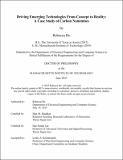Driving Emerging Technologies From Concept to Reality: A Case Study of Carbon Nanotubes
Author(s)
Ho, Rebecca
DownloadThesis PDF (16.53Mb)
Advisor
Shulaker, Max
Lee, Hae-Seung
Terms of use
Metadata
Show full item recordAbstract
The evolution of electronics has transformed nearly every aspect of society and has been fueled by decades of relentless device scaling. However, electronics is facing a paradigm shift as serious obstacles challenge future progress. Continued scaling is growing increasingly difficult and already yields diminishing energy efficiency benefits. At the same time, other obstacles such as data bandwidth bottlenecks, interconnect density limitations, and reliability are limiting computing performance. Therefore, traditional routes to progress are insufficient, and new approaches must be investigated if we are to continue the technological advancement society has come to expect.
One major thrust toward overcoming these obstacles is the search for alternative, beyond-silicon technologies. Yet despite the promise of these emerging nanotechnologies, their nascency has made their integration into practical and useful electronic systems challenging. In my thesis, I aim to tackle this challenge and present a roadmap for how such new and immature nanotechnologies can be leveraged to not only set the foundation for futuristic next-generation hardware, but also realize practical systems that can have an impact today. As a case study, I use carbon nanotubes (CNTs) to demonstrate a realistic roadmap for commercially realizing these next-generation technologies. First, I show, for the first time, that every type of today’s conventional circuitry (digital, analog, and mixed-signal circuits) can be fabricated with CNT field-effect transistors (CNFETs). This provides a pathway for adopting these futuristic technologies today. Second, to show how CNFETs can play a role in the next generation of computing systems, I leverage the unique low-temperature fabrication of CNFETs alongside emerging memory technologies to achieve the finest 3D integration of emerging technologies to date, which I further use to enable a new circuit design technique. Third, to show how CNFETs can enable futuristic electronic systems that can impact application spaces beyond conventional computing, I leverage VLSI-compatible foundry fabrication of CNFETs to realize BioSensor chips capable of detecting and identifying infectious pathogens in liquid. These experimental demonstrations of CNFETs in today’s (conventional circuitry), tomorrow’s (dense fine-grained 3D systems), and futuristic (healthcare diagnostics) applications explicitly demonstrate a practical roadmap for how emerging nanotechnologies can be developed for near-term adoption while providing longer-term motivation for enabling next-generation electronic systems.
Date issued
2023-06Department
Massachusetts Institute of Technology. Department of Electrical Engineering and Computer SciencePublisher
Massachusetts Institute of Technology